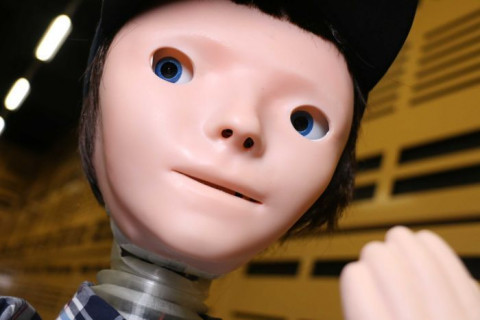
"My favourite pizza is pepperoni pizza."
Kaspar has introduced himself to nine-year-old Joshua Whelan.
"Mine is cheese, feta and olives," said Joshua, encountering the tiny robot for the first time.
"Sounds yummy."
Kaspar is a moving, talking humanoid developed specifically for children on the autism spectrum, now being trialled for the first time in Australia.
He can be programmed to hold conversations with children who may find social interactions daunting.
If you find Kaspar's appearance a little disturbing, you might be showing your age.
 Photo: Joshua Whelan with social robot Kaspar, whose purpose is to help children on the autism spectrum socialise. (ABC News: Tom Hancock)
Photo: Joshua Whelan with social robot Kaspar, whose purpose is to help children on the autism spectrum socialise. (ABC News: Tom Hancock)
While adults generally reacted cautiously to Kaspar, researchers said children responded more positively.
Kaspar was developed at the University of Hertfordshire in England, and every aspect of the robot's appearance has been carefully considered.
The robot is deliberately the size of a small child, so it does not intimidate its target audience.
Kaspar has minimal facial expressions in order not to overwhelm children on the autistic spectrum and to allow them to individually interpret the robot's expressions.
"From what we've seen the children have been quite interested and attracted to Kaspar," said Scott Brown, an Associate Lecturer at the University of New South Wales' Faculty of Art and Design.
Mr Brown is conducting a pilot project with Kaspar in conjunction with CSIRO.
Designers used a child's resuscitation mask as the basis for the facial design, which might explain Kaspar's arguably ghoulish look, but it was deemed to lend a timeless and neutral expression to the robot.
"The repeatability and the capability to manage expectation of interaction is quite strong with a robot, so that helps us work with a child that might not have those skills," Mr Brown said.
"A social robot like Kaspar can be a useful way to scaffold to face-to-face [human] interaction," he said.
Kaspar has been trialled with a handful of autistic children in the UNSW and CSIRO study, and the results are currently being evaluated.
Meeting a new person 'overwhelming' for autistic children
Kaspar is also programmed to hone in on specific social situations which the individual child finds challenging, such as sustaining a conversation, or meeting a new person.
"For autistic children, meeting a new person can be overwhelming or frightening even, and so conducting that interaction through the robot can be a nice way of bringing those people together," Mr Brown said.
 Infographic: Kaspar does not look like the robots usually portrayed in pop culture. (Unsplash: @rocknrollmonkey)
Infographic: Kaspar does not look like the robots usually portrayed in pop culture. (Unsplash: @rocknrollmonkey)
"It's another tool in our toolkit for working with any children or anybody who has any sort of social communication difficulties," he said.
Social robotics is an emerging field and long-term studies are needed to determine whether the machines really are teaching humans valuable life skills.
"At the end of the day what we want is the kids to learn how to interact with humans, not how to interact with robots," CSIRO research scientist David Silvera-Tawil said.
"It's not a toy.
"We have to be very clear that it's not a peer that they can play with and interact with...it's a tool to help learning."
Robots teaching students yoga and science
At Murray Bridge High School in South Australia, the CSIRO is closely monitoring work being done with two social Nao robots, named Sam and Phil.
The school's disability unit has been using the robots for more than two years in a range of settings including science, yoga, IT lessons, and sessions aimed at boosting the students' social skills.
 Photo: Two robots at Murray Bridge High School in Adelaide encourage students to think about coping strategies. (ABC News: Barbara Miller)
Photo: Two robots at Murray Bridge High School in Adelaide encourage students to think about coping strategies. (ABC News: Barbara Miller)
The robot is programmed to talk about what it does when feeling stressed, encouraging the students, many of whom are on the autism spectrum, to think about their own coping strategies.
Mr Silvera-Tawil said the results from South Australia so far are encouraging.
"Some of the kids who were nervous to interact in group activities were suddenly open and were willing to participate in group activities, just because they were willing to with the robot," he said.
 Photo: Sam the robot leads a yoga class at a South Australian high school in Murray Bridge. (ABC News: Barbara Miller)
Photo: Sam the robot leads a yoga class at a South Australian high school in Murray Bridge. (ABC News: Barbara Miller)
"They wanted to be part of the technology that everyone was excited about, so because of that they started interacting more with the robot, but also more with their peers."
Confidence boosters
 Photo: Murray Bridge High student Taylah Hilton said the Nao robots have grown on her. (ABC News: Barbara Miller)
Photo: Murray Bridge High student Taylah Hilton said the Nao robots have grown on her. (ABC News: Barbara Miller)
The robots were introduced to the school by the Disability Unit Manager Christine Roberts-Yates, who said they had a marked impact.
"They're attractive, they're well-designed, they're patient," she said.
"They are a computer, they're programmed to be all of those things, but the students just love working with them."
Ms Roberts-Yates said she had noticed a definite boost to students' self-esteem and confidence as a result of working with the robots.
Sixteen-year-old Taylah Hilton said she initially found the robots "creepy and disturbing".
Now though, she said, "I love them more than anything."